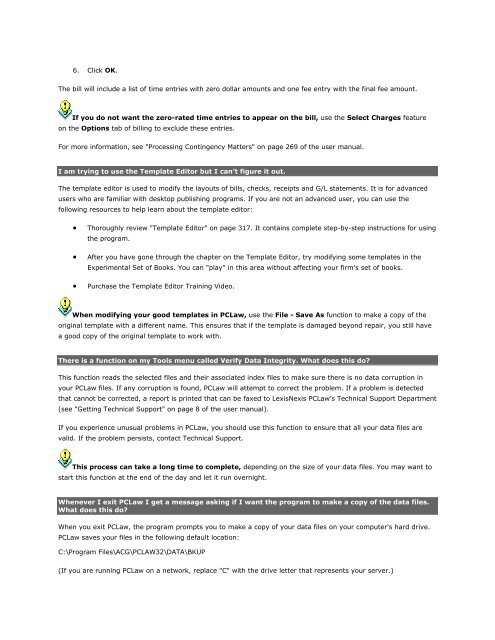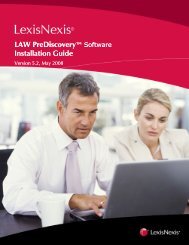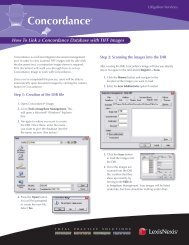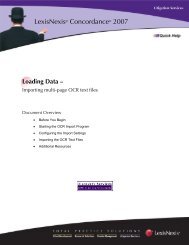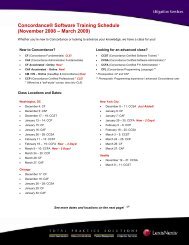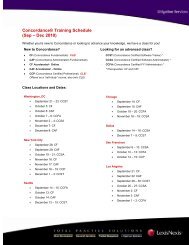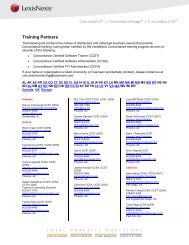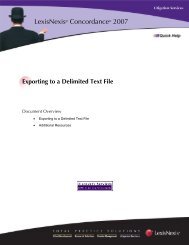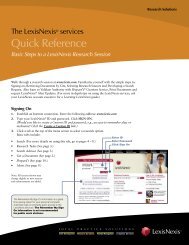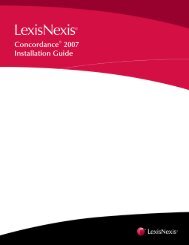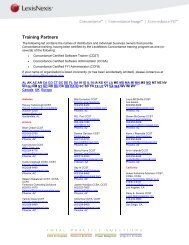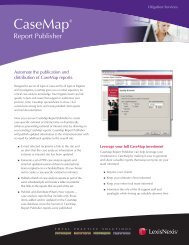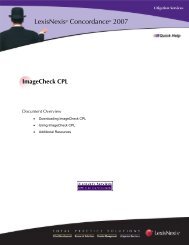Frequently Asked Questions - LexisNexis
Frequently Asked Questions - LexisNexis
Frequently Asked Questions - LexisNexis
You also want an ePaper? Increase the reach of your titles
YUMPU automatically turns print PDFs into web optimized ePapers that Google loves.
6. Click OK.<br />
The bill will include a list of time entries with zero dollar amounts and one fee entry with the final fee amount.<br />
If you do not want the zero-rated time entries to appear on the bill, use the Select Charges feature<br />
on the Options tab of billing to exclude these entries.<br />
For more information, see "Processing Contingency Matters" on page 269 of the user manual.<br />
I am trying to use the Template Editor but I can’t figure it out.<br />
The template editor is used to modify the layouts of bills, checks, receipts and G/L statements. It is for advanced<br />
users who are familiar with desktop publishing programs. If you are not an advanced user, you can use the<br />
following resources to help learn about the template editor:<br />
• Thoroughly review "Template Editor" on page 317. It contains complete step-by-step instructions for using<br />
the program.<br />
• After you have gone through the chapter on the Template Editor, try modifying some templates in the<br />
Experimental Set of Books. You can "play" in this area without affecting your firm’s set of books.<br />
• Purchase the Template Editor Training Video.<br />
When modifying your good templates in PCLaw, use the File - Save As function to make a copy of the<br />
original template with a different name. This ensures that if the template is damaged beyond repair, you still have<br />
a good copy of the original template to work with.<br />
There is a function on my Tools menu called Verify Data Integrity. What does this do?<br />
This function reads the selected files and their associated index files to make sure there is no data corruption in<br />
your PCLaw files. If any corruption is found, PCLaw will attempt to correct the problem. If a problem is detected<br />
that cannot be corrected, a report is printed that can be faxed to <strong>LexisNexis</strong> PCLaw’s Technical Support Department<br />
(see "Getting Technical Support" on page 8 of the user manual).<br />
If you experience unusual problems in PCLaw, you should use this function to ensure that all your data files are<br />
valid. If the problem persists, contact Technical Support.<br />
This process can take a long time to complete, depending on the size of your data files. You may want to<br />
start this function at the end of the day and let it run overnight.<br />
Whenever I exit PCLaw I get a message asking if I want the program to make a copy of the data files.<br />
What does this do?<br />
When you exit PCLaw, the program prompts you to make a copy of your data files on your computer's hard drive.<br />
PCLaw saves your files in the following default location:<br />
C:\Program Files\ACG\PCLAW32\DATA\BKUP<br />
(If you are running PCLaw on a network, replace "C" with the drive letter that represents your server.)


